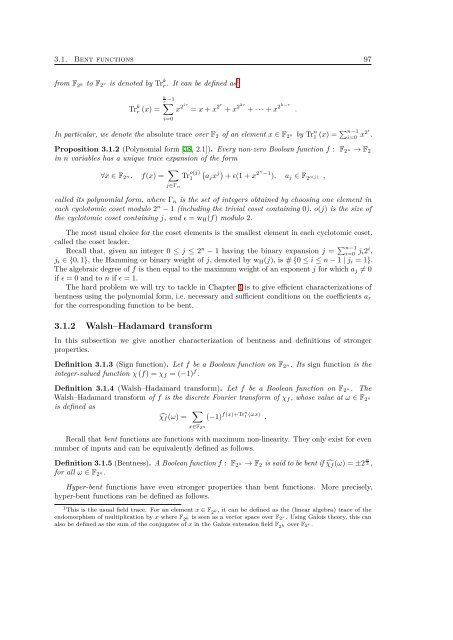here - Sites personnels de TELECOM ParisTech - Télécom ParisTech
here - Sites personnels de TELECOM ParisTech - Télécom ParisTech
here - Sites personnels de TELECOM ParisTech - Télécom ParisTech
You also want an ePaper? Increase the reach of your titles
YUMPU automatically turns print PDFs into web optimized ePapers that Google loves.
3.1. Bent functions 97from F 2 k to F 2 r is <strong>de</strong>noted by Tr k r. It can be <strong>de</strong>fined as 1kr −1∑Tr k r (x) = x 2ir = x + x 2r + x 22r + · · · + x 2k−r .i=0In particular, we <strong>de</strong>note the absolute trace over F 2 of an element x ∈ F 2 nby Tr n 1 (x) = ∑ n−1i=0 x2i .Proposition 3.1.2 (Polynomial form [38, 2.1]). Every non-zero Boolean function f : F 2 n → F 2in n variables has a unique trace expansion of the form∀x ∈ F 2 n, f(x) = ∑ (aj x j) + ɛ(1 + x 2n−1 ), a j ∈ F 2 o(j) ,Tr o(j)1j∈Γ ncalled its polynomial form, w<strong>here</strong> Γ n is the set of integers obtained by choosing one element ineach cyclotomic coset modulo 2 n − 1 (including the trivial coset containing 0), o(j) is the size ofthe cyclotomic coset containing j, and ɛ = w H (f) modulo 2.The most usual choice for the coset elements is the smallest element in each cyclotomic coset,called the coset lea<strong>de</strong>r.Recall that, given an integer 0 ≤ j ≤ 2 n − 1 having the binary expansion j = ∑ n−1i=0 j i2 i ,j i ∈ {0, 1}, the Hamming or binary weight of j, <strong>de</strong>noted by w H (j), is # {0 ≤ i ≤ n − 1 | j i = 1}.The algebraic <strong>de</strong>gree of f is then equal to the maximum weight of an exponent j for which a j ≠ 0if ɛ = 0 and to n if ɛ = 1.The hard problem we will try to tackle in Chapter 4 is to give efficient characterizations ofbentness using the polynomial form, i.e. necessary and sufficient conditions on the coefficients a rfor the corresponding function to be bent.3.1.2 Walsh–Hadamard transformIn this subsection we give another characterization of bentness and <strong>de</strong>finitions of strongerproperties.Definition 3.1.3 (Sign function). Let f be a Boolean function on F 2 n. Its sign function is theinteger-valued function χ (f) = χ f = (−1) f .Definition 3.1.4 (Walsh–Hadamard transform). Let f be a Boolean function on F 2 n. TheWalsh–Hadamard transform of f is the discrete Fourier transform of χ f , whose value at ω ∈ F 2 nis <strong>de</strong>fined aŝχ f (ω) = ∑(−1) f(x)+Trn 1 (ωx) .x∈F 2 nRecall that bent functions are functions with maximum non-linearity. They only exist for evennumber of inputs and can be equivalently <strong>de</strong>fined as follows.Definition 3.1.5 (Bentness). A Boolean function f : F 2 n → F 2 is said to be bent if ̂χ f (ω) = ±2 n 2 ,for all ω ∈ F 2 n.Hyper-bent functions have even stronger properties than bent functions.hyper-bent functions can be <strong>de</strong>fined as follows.More precisely,1 This is the usual field trace. For an element x ∈ F 2 k , it can be <strong>de</strong>fined as the (linear algebra) trace of theendomorphism of multiplication by x w<strong>here</strong> F 2 k is seen as a vector space over F 2 r . Using Galois theory, this canalso be <strong>de</strong>fined as the sum of the conjugates of x in the Galois extension field F 2 k over F 2 r .
















